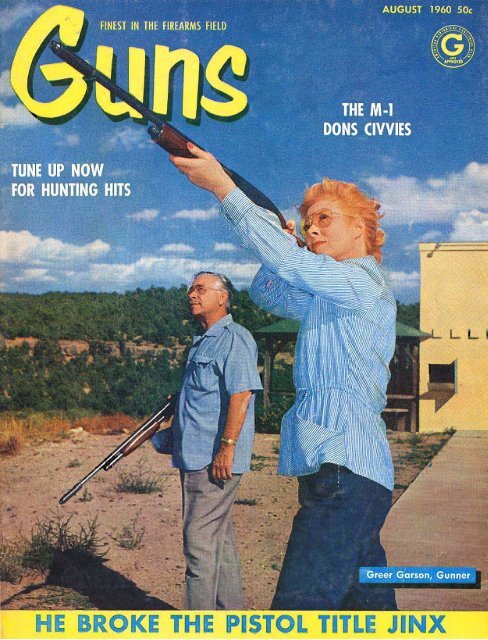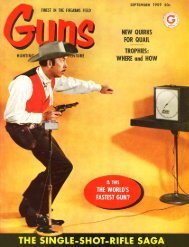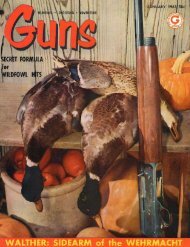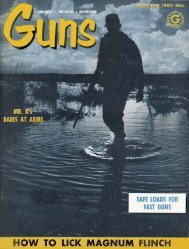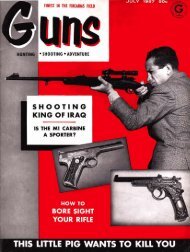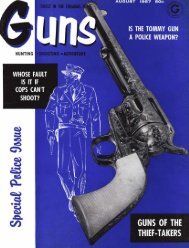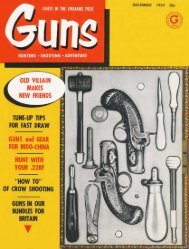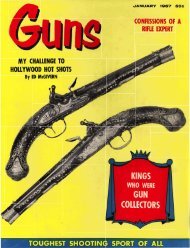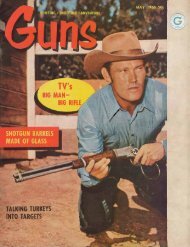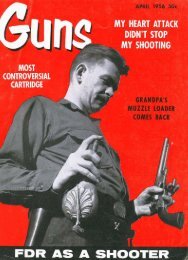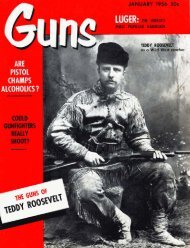You also want an ePaper? Increase the reach of your titles
YUMPU automatically turns print PDFs into web optimized ePapers that Google loves.
ISTOL TilL JINX<br />
LL
E. B. Mann. . Editor<br />
Wm. B. Edwards Technical Editor<br />
Elmer Keith Shooting Editor<br />
Kent Bellah Handloading<br />
Roslyn Wallis Editorial Ass't<br />
Sydney Barker Art Director<br />
Lew Merrell '. Ass't Art Director<br />
Marvin Ginn ..... Advertising Director<br />
Lee Salberg Ass't Adv. Dir.<br />
Lou Weber Advertising Sales<br />
M. Magnusson Classified Adv.<br />
Sanford Herzog .. Production Manager<br />
Kay Elliott..... Ass't Production Mgr.<br />
Lou Satz Circulation Manager<br />
George Tsoris Promotion Manager<br />
Editorial Advisory Board<br />
Col. George M. Chinn Military<br />
Carola Mandel Skeet<br />
Stuart Miller Cartridges<br />
Val Forgett Collectors<br />
Dee Woolem ..............••.... Fast Draw<br />
Bill Toney .....•••••••••••••••.•.... Police<br />
Les Field __ Legislation<br />
THE COVER<br />
Being a pretty girl isn't enough to put you<br />
on our cover. Being a screen personality<br />
is not enough, either. Not even being a<br />
gunner will do it, necessarily. But when all<br />
three are combined in a superlative kodachrome<br />
as has been done in this instance<br />
-well, even editors are human. The pic·<br />
ture is by Harvey Caplin of Albuquerque,<br />
New Mexico.<br />
shooting ...<br />
George E. von Rosen<br />
Publisher<br />
Arthur S. Arkush<br />
Ass't to the Publisher<br />
IN THIS ISS U E<br />
AUGUST. <strong>1960</strong><br />
Vol. VI, No. 8·68<br />
HE BROKE THE PISTOL TITLE JINX " Grits Gresham 16<br />
A TRICK TO MAKE YOU SHOOT BETTER Clifford W. Cox 22<br />
GREER GARSON, GUNNER Clifton Camp 33<br />
LITTLE THINGS BEHIND THE LONG SHOTS Harold W. Harton 41<br />
special ...<br />
FRANCIS POWERS' PISTOL. George B. Johnson 19<br />
new rifle ...<br />
A HOT NEW WINCHESTER AUTOMATIC Elmer Keith 20<br />
. ..William B. Edwards 21<br />
workshop ...<br />
TUNE UP NOW FOR HUNTING HITS Robert J. Kindley 24<br />
THE M.I DONS CiVViES Don Crittenden 28<br />
guns americana . . .<br />
GUN OF THE MONTH: CANADA RIFLE R. Alan Douglas 27<br />
BIG BUSINESS IN SMALL PARTS William B. Edwards 30<br />
departments . . .<br />
KNOW YOUR LAWMAKERS. 4<br />
GUN RACK. . 6<br />
ELMER KEITH SAYS . . . .. . .. . .. . Elmer Keith 8<br />
CROSSFIRE. . ... " . .. .. . . . . .. 10<br />
PU LL!. . . .. . .. . .. .. . .. . . . . Dick Miller 12<br />
ARMS LIBRARY. . . . . . .. .. . . .. .. . . . 14<br />
SHOPPING WITH <strong>GUNS</strong>.. . Roslyn Wallis 56<br />
THE GUN MARKET. . , 64<br />
INDEX OF ADVERTISERS... . 66<br />
..<br />
EDITORIAL OFFICES: E. B. Mann, W. B. Edwards. 8150 N. Central Park, Skokie, III., ORchard 5·5602<br />
Elmer Keith. Salmon, Idaho. Kent Bellah, Saint Jo, Texas.<br />
REPRESENTATIVES: NEW YORK, Eugene L. Pollock, 60 East 42nd St., New York 17, N. Y.. YUkon<br />
6.9280. MIDWEST ADV. OFFICES, 8150 N. Central Park Ave., Skokie, III .• ORchard 5-6967. CALI·<br />
FORNIA The Ren Averill Co., Ren Averill, 232 N. Lak" Ave., Pasadena, Calif. MUrray 1-7123.<br />
SOUTHERN, Hal Moore, 279 NE 79th St., Miami 38, Fla. PLaza 8·5516.<br />
<strong>GUNS</strong> AUGUST <strong>1960</strong> 5
Jam pistol solidly into hand and then wrap<br />
those fingers tightly is Clark's grip system.<br />
His Ruger has custom grips to<br />
match feel of his Colt .38, .45.<br />
IN 1958. JIM CLARK BROKE<br />
THE LONG-TIME "MEN IN UNIFORM<br />
ONLY" GRIP ON THE NATIONAL<br />
PISTOL CHAMPIONSHIP<br />
16<br />
He Broke.he<br />
Only civilian national pistol champ has no secrets<br />
in his guns: tun·ed up .45, .38 conversion, and .22.<br />
<strong>GUNS</strong> • AUGUST 19'1
Pis.ol Ti.le Jinx...<br />
"THE MOST IMPORTANT SIX INCHES in competitive pistol shooting,"<br />
says Jim Clark, "are the inches directly between the shooter's ears." .<br />
Clark's record entitles him to opinions about pistol-punching paper targets.<br />
That record includes many major-tournament victories, a dozen and a half<br />
national records, and a houseful of trophy hardware. But the thing that makes<br />
James E. Clark, the pistolsmith from Shreveport, Louisiana, completely unique<br />
in the world of handgun shooting-and perhaps the thing that best proves the<br />
above statement-is the fact that he is the only civilian ever to have won the<br />
National Pistol Championship.<br />
It happened at Camp Perry, of course, in <strong>August</strong> of 1958. The men and<br />
women who fired those 1958 matches will not forget them. Shooting conditions<br />
can be rough there on the shore of Lake Erie, and the weather during "pistol<br />
week" in 1958 was less than ideal, to put it mildly. Scores suffered, and so did<br />
the shooters. Among the select coterie of top Masters who might win, it was a<br />
battle. of nerves, of concentration, of trying to outguess the weather gremlins.<br />
Competitive shooters without exception believe that no sport applies greater<br />
pressure, produces more tension, than the shot-by-shot ordeal of big-time target<br />
competition. One point lost on one shot can put you three or four-or even a<br />
Champ's stance shows relaxed but steady quality that won him<br />
National pistol title on basis of good aggregate of all matches.<br />
<strong>GUNS</strong> AUGUST <strong>1960</strong><br />
By GRITS GRESHAM<br />
17
At "Holiday in Dixie" matches Clark, typically the lone<br />
civilian among uniforms, spots careful shots that win.<br />
Backed by impressive array of trophies, Clark holds<br />
gold-lined Model 41 pistol he got with champ title.<br />
dozen-places down in the final ranking. Even under ideal<br />
conditions, when "all you have to do is hold and squeeze,"<br />
the strain is terrific. It's worse when winds are gusting<br />
your gun off target and light is affecting your sight picture.<br />
Multiply this by 270-the number of shots to be fired-and<br />
you begin to get the picture.<br />
If you're not familiar with the course of fire in U.S.<br />
pistol competition, it consists of 90 shots with a .22 caliber<br />
gun, 90 more .with "any centerfire pistol of .32 caliber<br />
or larger," and 90 more with a .45 caliber pistol. With 10<br />
points possible on each shot, the perfect aggregate score<br />
would be 2700. For many years, a score of 2600 out of<br />
2700 was considered as "impossible" as the four-minute<br />
mile. Even today, the "2600 club"-composed of shooters<br />
who have broken that magic score-is one of the most<br />
select and restricted groups in sport. Jim Clark is a<br />
member.<br />
He didn't break 2600 at the 1958 National Matches,<br />
however. In fact, nobody paid Jim Clark much attention.<br />
He was near the top but did not win the first day's .22<br />
caliber matches. He was near the top but did not win the<br />
Center Fire competition. He was near the top but did not<br />
win the .45 caliber matches, either. But those near-the-top<br />
scores added to a grand aggregate score of 2598-to top the<br />
best efforts of 1300 of the country's finest handgunners<br />
and make him National Champion.<br />
"So?" you say. "Somebody has to win, no? Somebody<br />
wins every year, yes? So what makes this different?"<br />
What makes it different was that Jim Clark was (and<br />
is) a civilian. Throughout all the many years of competition,<br />
the National Pistol Championship had gone always<br />
to a law enforcement officer or a member of the Armed<br />
Forces. These men are "professionals" at least in the sense<br />
that they use pistols in their everyday work. Many of them,<br />
particularly in late years with the development of the<br />
special Marksmanship Units in the various Armed Forces,<br />
are not only furnished guns and ammunition but shooting<br />
practice is made their full-time occupation. Jim Clark has<br />
never had these advantages. He fires his own guns, his own<br />
ammunition, on his own time.<br />
In the 1959 National Matches, Jim bettered his winning<br />
1958 score by four points, shooting a 2602x2700, with<br />
106 X's. But the scores were higher this time, and Clark<br />
came in fifth overall, with Joe Benner firing a 2615 to take<br />
the crown. Jim won the Civilian Championship; all four<br />
men who topped his score were in uniform.<br />
How is he able to overcome the obvious advantages of<br />
unlimited time, facilities, ammunition, coaching, and<br />
practice that has always-except once-brought a "service"<br />
shooter through to the crown? The answer could be<br />
that he also has all of these advantages for developing his<br />
skill, but such is not the case.<br />
Lack of time limited his practice to six sessions in the<br />
year 1959 up until May 2, which was the date of the<br />
"Holiday in Dixie" Pistol Matches in Shreveport. Despite<br />
that lack of practice, he fired an amazing 2642, the highest<br />
score of his career. It set a new civilian record, yet he<br />
lost the match by four points to Lt. David Cartes, of the<br />
U.S. Army Advanced Marksmanship Unit. Cartes had been<br />
with that Unit for five years. His one assignment has been<br />
to become the best pistol shot possible. In contrast, with<br />
a half dozen practice firings, Jim Clark was only four<br />
points shy.<br />
. At the Louisiana State Pistol Championships in September,<br />
Jim set another new national record, this time in<br />
the- .22 Rapid Fire Course. His score of 200-18X upped<br />
the old mark of 200·17X. In the same meet, he equalled<br />
another national record which he holds, by firing another<br />
299x300 in the .22 National Match Course. Even in equalling<br />
it, however, he made it more difficult to break, since<br />
in the rapid fire phase of it he shot a perfect 100. His old<br />
record was set with a 99 in rapid fire-which is the event<br />
used as a tie-breaker under the Creedmoore system of<br />
scoring.<br />
There must be some explana- (Continued on page 40)<br />
18 Gu-NS AUGUST <strong>1960</strong>
Francis Po-w-ers' Pistol<br />
Copper wire screen disks surround .22<br />
caliber barrel in OSS silencer. Holes<br />
permit gas to escape while screen slows<br />
it down, dampening the report of shot.<br />
ON MAY 1, <strong>1960</strong> a much misunderstood firearm accessory<br />
was blasted into world attention when a "U.S. spy<br />
plane" was forced down in Russia. Given star billing<br />
along with the captured pilot, a truck load of scrap aluminum,<br />
and a poison needle, was a "noiseless pistol." The old<br />
fashioned, American-invented silencer has not received so<br />
much attention since its birth in the early horse and buggy<br />
part of this century; and here it was playing a bit part in<br />
this drama of the atomic age. The weapon displayed by the<br />
Soviets was a .22 caliber Hi-Standard Automatic Pistol with<br />
a tubular silencer encasing the barrel. It appeared to be the<br />
H-D Military (HDM) model as used by the Office of Strategic<br />
Services in their behind the lines work in World War<br />
II, fitted with the regulation High Standard "wire screen"<br />
silencer barrel.<br />
As a "gun expert" in a small town I suddenly· had to<br />
answer a lot of questions about "noisless· guns." Young<br />
hunters wanted to know if they could be used in shooting<br />
varmints with their .222. Only the senior sportsmen remembered<br />
much about the (Continued on page 47)<br />
<strong>GUNS</strong> AUGUST <strong>1960</strong><br />
BIGGEST NOISE AT THE<br />
SUMMIT MEETING WAS SILENT<br />
PISTOL OF AGENT POWERS<br />
By GEORGE B. JOHNSON<br />
Before anti-silencer law of 1934 Maxim firm did<br />
small business in sound moderators for hunting guns.<br />
19
ELMER KEITH REPORTS ON<br />
SHOOTING TESTS. BILL EDWARDS<br />
SKETCHES HISTORY OF<br />
AHot, New<br />
Winchester<br />
Automatic<br />
By ELMER KEITH<br />
WINCHESTER'S NEW auto-loading rifle, the Model<br />
100, is an entirely new concept in auto-loading<br />
actions, taken from the M-14 military rifle, which Winchester<br />
also manufactures, and applied to a sporting rifle.<br />
The important feature is a cut-off gas expansion system, that<br />
will bleed off the same amount of gas to operate the action,<br />
each shot, regardless of powder loads or bullet weights.<br />
Use light bullets or heavy, mInImUm loads or heavy<br />
charges, and the gas chamber meters off the same amount<br />
of gas for each shot. This makes for a very smooth,<br />
uniform, auto-loading action.<br />
The gas chamber and piston comprise the assembly,<br />
that bleeds off the operating gas from the bore, and is<br />
fixed to the barrel by a dovetail member. The gas cylinder<br />
is connected to the barrel through a gas port. A slot about<br />
three-fourths inch to the rear of the gas port provides a<br />
vent to the outside. The piston, which is a close fit within<br />
the gas cylinder, is connected to the action by double<br />
operating rods. It is hollow, to provide adequate volume<br />
area in a minimum of space.<br />
A hole in the piston wall permits gas entry to initiate<br />
piston movement. As the bullet moves down the bore and<br />
passes the gas port, gas flows into the cylinder. This gas,<br />
acting in all directions, pushes the piston and slide to the<br />
rear. This in turn moves the piston, closing the gas port,<br />
and cutting off any further gas supply. It meters out the<br />
exact amount needed to operate the action each shot.<br />
The gas trapped inside the cylinder. expands against the<br />
piston for approximately three-fourths of an inch, at which<br />
time the piston gas port reaches the slot in the cylinder<br />
and vents the gas to the outside. At this point of piston<br />
travel, the major work of opening the action and ejecting<br />
the fired cartridge has been accomplished, and no further<br />
gas energy is needed to complete the automatic action.<br />
Operation of the piston movement is controlled by gas<br />
pressure, and if the pressure of the cartridge is high, the<br />
piston moves faster to cut off the gas supply. If a lower<br />
pressure load is used, the piston moves slower; but in each<br />
case, it meters out the same exact amount of pushing gas<br />
to be converted into kinetic energy. Thus this excellent<br />
system provides a soft, uniform action operation with all<br />
bullet weights.<br />
The rifle utilizes a cam-action rotating bolt that locks<br />
at the head of the bolt directly behind the cartridge. The<br />
outstanding feature of the Model 100 is the cut-off gasexpansion<br />
design adapted from the military M-14 rifle by<br />
Winchester.<br />
The new rifle is as streamlined and smooth as a chorus<br />
gal, with very good lines. The weight is around 7%<br />
20 <strong>GUNS</strong> AUGUST 196D
"Streamlined as a chorus gal," quoth<br />
Keith about WRACo Model 100. Absence<br />
of gadgets and protrusions on<br />
sleek breech is unusual in an auto rifle.<br />
New sporter took tough tests okay.<br />
pounds. Barrel length is 22 inches and the one-piece stock<br />
design, adopted in the interest of accuracy, has a long<br />
forearm of excellent shape for the long-armed shooter.<br />
Sling swivels are also provided. Grip and forend are finely<br />
checkered, and a good grade of American walnut is used<br />
in the stock.<br />
All major action parts are forgings machined for smooth<br />
operation and longevity. Three heavy, rotating locking lugs<br />
are designed to bear equally on closing. (It is important<br />
that they do bear equally. I have found many bolt actions<br />
that bore hard on one lug and would not even smear the<br />
grease on the other.) .<br />
The M-100 is a five-shot rifle. (Continued on page 33)<br />
1. Barrel 13. Guard Screw 25. Piston<br />
2. Bolt 14. Hammer 26. Rear Sight-Lyman 16A<br />
3. Bolt Sleeve 15. Hammer Lock 27. Receiver<br />
4. Bolt Sleeve Lock 16. Maga.zine Assembly 28. Recoil Block<br />
5. Butt Plate 17. <strong>Magazine</strong> Follower 29. Recoil Block Screw<br />
6. Firing Pin 18. <strong>Magazine</strong> Lock 30. Safety<br />
7. Forearm Screw 19. <strong>Magazine</strong> Lock Housing 31. Stock<br />
8. Front-Sight-l03C-Hooded 20. Operating Slide Arms 32. Stock Swivel Screw Assembly<br />
9. Gas Cylinder 21. Operating Slide Guide 33. Trigger<br />
10. Gas Cylinder Cap 22. Operating Slide Springs 34. Trigger Lock<br />
11. Gas Cylinder Housing 23. Operating Slide Spring Guide 35. Trigger Lock Lever<br />
12. Guard :!4. Pistol Grip Cap<br />
<strong>GUNS</strong> . AUGUST. <strong>1960</strong> 21
-<br />
•<br />
SIGHTING THROUGH CARD<br />
IS A STUNT ANYBODY CAN DO,<br />
PRACTICAl.· ADVANTAGES TOO<br />
D ID<br />
I EVER SHOW YOU how I can see a target<br />
through a playing card?"<br />
I was pretty young then, and dad and I were shooting<br />
a .22 rifle at bottle caps stuck on a fence post. He was<br />
always joshing me, and I thought this was just more of the<br />
same-until he sent me to the house for a card, punched<br />
a hole in it, and put the card on the rifle barrel in front of<br />
the front sight. "Now put up another bottle cap," he said.<br />
The idea of hitti.ng a bottle cap you couldn't see to sight<br />
·on struck me as pretty silly. You could come close, just by<br />
ATrick To ,Make<br />
You Shoot Better<br />
By CLIFFORD W. COX<br />
lining the rifle up on the post and sort of guessing where<br />
the cap was; but to hit that small target at the range we<br />
were shooting, the sights had to be on it. ... But dad hit<br />
it. He hit another, and another, and another. It proved to<br />
me what I had suspected all along-that my dad was a<br />
pretty extra-ordinary fellow. I didn't know then that any<br />
shooter can do it. That is, any shooter with two eyes . . .<br />
Ever since sights were put on guns, a lot of people have<br />
thought that you have to close one eye to take good ai.m.<br />
This makes about as much sense as saying that you could<br />
22 <strong>GUNS</strong> AUGUST <strong>1960</strong>
un better if you had only one leg. Two eyes give you<br />
visual advantages you just can't get with one eye-and I<br />
don't mean "seeing through a playing card," either. The<br />
playing card trick, however, is a way to prove it.<br />
Try sighting a gun with both eyes open, without the<br />
playing card. If you've always used one eye for sighting,<br />
the first time you try it with both eyes open you'll probably<br />
wonder how anybody can do it. You'll get a double<br />
image, and you won't be able to fit the sights into either<br />
image. Try closing the eye you usually close for sighting,<br />
get the sight picture fixed-then open the closed eye<br />
slowly. When the double image comes back, do the same<br />
With front sight blocked, target cannot be seen<br />
by right-eyed aimer. But, you're right, there is •••<br />
thing again. Each time you do it, the sight picture will<br />
hold true for a longer time and you're that much nearer<br />
to double-eyed sight vision.<br />
Why go to all that trouble? Two-eyed sighting has many<br />
advantages in practical shooting, and we'll go into that<br />
later. But first let's complete the story of the playing card.<br />
Punch a hole through a playing card or any similarly<br />
sized piece of cardboard, and fix it over the end of the gun<br />
barrel so that it blocks the line of sight completely. Sighting<br />
with one eye, you can't see the target.<br />
Now close the sighting eye and open the other one. You<br />
see the target, and you see the barrel of the gun slanting<br />
away at an "unnatural" angle. You can't tell whether the<br />
sights are on target or not.<br />
Now open both eyes. Now you see the sights, and the<br />
card ... and you see the target and the slanting gun barrel.<br />
Probably you see them as double images, both fuzzy. But<br />
keep looking. Gradually, the two images -merge and you<br />
actually seem to see the target through the card. The target<br />
image may be blurred, but it's there-and you can hit<br />
it. The more you practice, the (Continued on page 46)<br />
<strong>GUNS</strong><br />
AUGUST <strong>1960</strong><br />
... A joker in the deal. With left eye also open, image<br />
of clay bird will register to permit you to take aim.<br />
Through practice, you will be able to "see" phantom<br />
clay bird through the card, making a hit. Stunt is a<br />
true exercise of skill, not a cheat or childish trick.<br />
23
THE OLD • THE NEW • THE UNUSUAL<br />
NEW AMERICAN RIFLE IS HEAVY<br />
SPORTER OF THE NORTH<br />
By R. ALAN DOUGLAS<br />
FOR MANY YEARS collectors have assumed that any muzzle-loading gun lacking<br />
proof marks was produced in the United States. This no longer holds true. New<br />
research has listed at least 700 gunsmiths working in Canada between 1600 and 1900.<br />
Undoubtedly, many of these men merely repaired the products of others, but an<br />
ever-growing roster of Canadian gun manufacturers is emerging. As in other countries,<br />
two means of identification present themselves: documentary sources, and the guns<br />
themselves. What makes the documentary study of the Canada Rifle such an absorbing<br />
hobby is that the makers were rarely out-and-out gunsmiths. Usually they described<br />
themselves in newspaper ads, county directories, etc., as bellhangers or blacksmiths. It<br />
often takes a good deal of sleuthing to relate even a signed gun to its maker and point<br />
of origin.<br />
The surest way to identify a Canada Rifle is to study the gun itself. When one<br />
knows what to look for, this type is just as distinctive as the Pennsylvania and Northwest<br />
varieties.<br />
The Canada Rifle is noted for its astonishingly heavy octagon barrel, ranging up to<br />
and even beyond .60 caliber.<br />
In the later 19th century at least, the stock was half-length, usually with a castingmetal<br />
forepiece. Near the lock, the stock was often heavily-proportioned, reminding<br />
one of the Canada Rifle's British ancestry. The butt, however, was frequently quite<br />
light, with the more-or-Iess pronounced "Roman nose" droop of the Pennsylvania<br />
long gun. Cheekrest and patchbox were optional. (Continued on page ·51)<br />
<strong>GUNS</strong> AUGUST <strong>1960</strong> 27
Proved In W<br />
The M·I D·<br />
By DON CRITTENDEN<br />
BELOVED BY Gis. THE GARA<br />
NOW AVAILABLE. MAKES A<br />
GUN ENTHUSIASTS have been altering military<br />
rifles into sporters since the first military<br />
rifles were issued; and why not, since the same characteristics-simplicity,<br />
strength, dependability, power-are<br />
required by both? The one thing lacking<br />
is beauty, and coversions have turned drab military<br />
weapons into some of the most beautiful sporters in<br />
the world. How extensive (and how expensive)<br />
such conversions need be depends solely on how<br />
much a man is willing to spend, in money and/or<br />
personal effort, to make his rifle fit his pers,onal<br />
needs and his personal fancies. The rifles themselves<br />
are relatively cheap; parts, produced on a '<br />
military scale, are both cheap and plentiful, as is<br />
ammunition. You can convert on a bargain basis, or<br />
-the sky's the limit.<br />
The U. S. Army caliber .30 MI rifle, commonly<br />
known as the Garan'd, is now available to sports-<br />
Beautiful, not butchered, is gunny-looking<br />
sporter converted from M-I Garand. Caliber<br />
is now .25-06, grouping 2%" at 100 yards.<br />
28 <strong>GUNS</strong> AUGUST <strong>1960</strong>
WANT A COCK FOR AN OLD KENTUCKY? OR A SEAR FOR A NEW<br />
MACHINE PISTO,,? CHANCES ARE THAT NUMRICH HAS IT-IF HE CAN FIND IT<br />
post war of 1946 that he might make a business successful<br />
if he stuck to a specialty, gun parts-within a specialtythe<br />
gun aspect of sporting goods sales. His million-dollar<br />
annual business seems to prove his idea successful. And,<br />
recently, after 14 years of mail order trade, his five storage<br />
and manufacturing buildings congenially flanked by huge<br />
"KEEP OUT-BY APPOINTMENT ONLY" signs, Numrich has<br />
taken the wraps off a mountain of parts in his new retail<br />
store.<br />
A grab-bag to delight gun enthusiasts has been created<br />
in West Hurley, under the able managership of Paul Terni.<br />
"Numrich has finally done the gun nut, gun putterer, and<br />
shooter a wonderful favor," says gunsmith Mason Williams<br />
(Shooters Services, Inc., in nearby Stanfordville, N. Y.)<br />
"With reloading supplies and all the gadgets that will<br />
delight the gun nut, I think he will hit the jackpot. I really<br />
think it is wonderful," Williams exclaims. But it has taken<br />
a revolution in the gun business to permit this to come<br />
about.<br />
It is a revolution many gun fanciers have long wanted<br />
to see come to pass. Perhaps it may be said to have dated<br />
from 1946, the year George Numrich really got established.<br />
In those bleak days there was a lot of housecleaning in the<br />
gun factories. War contracts were terminated and every·<br />
thing went to the junk pile. Remington Arms, for example,<br />
scrapped the fixtures and tooling and parts, mostly un·<br />
catalogued, for the New Model Army .44 percussion<br />
revolver made during the Civil War in that big factory in<br />
Ilion. I remember seeing a New Model Remington cylinder<br />
that had been rendered "unserviceable" by compr.essing it<br />
14" under a drop hammer. Aside from'being a little bulgy<br />
it was brand new. At Colt's, revolver parts, all of value<br />
but with no market due to the underdeveloped state of the<br />
gun sport game then were (Continued on page 52)<br />
Fastidious automatic pistol collector checks a big Astra .30 army pistol in new<br />
Numrich retail store. Salesman Paul Terni wears belted Magnum to discourage crooks.
GREER GARSON, GUNNER<br />
GREER GARSON, shown here and on our cover, is not<br />
a skeet champ.ion, but she is a champion of skeet<br />
shooting, and a lovely example of the vastly growing distaff<br />
interest in the shooting sports. Brought up as a child to fear<br />
guns, "but fascinated by them even then," Greer Garson<br />
now breaks an average 18 out of 25 skeet targets, considers<br />
the skeet range one of the best features of the New Mexico<br />
ranch home built for her by her crack-shooting husband,<br />
oil-man Colonel E. E. "Buddy" Fogelson.<br />
Born in County Down, Ireland, Greer Garson has been<br />
a part of the international social and cinema scene around<br />
the world; but Forked Lightning Ranch-a fine, rambling,<br />
adobe ranchhouse atop a pinon-covered hill overlooking<br />
the Pecos River-is, she says, "where my heart is." On<br />
<strong>GUNS</strong> AUGUST <strong>1960</strong><br />
SCREEN STAR SAYS WOMEN SHOULD<br />
LEARN TO SHOOT FOR SELF<br />
PROTECTION AND FUN<br />
By CLIFTON CAMP<br />
location now for the production of her next picture, "Sunrise<br />
At Campobello," in which she plays the part of Mrs.<br />
Franklin Delano Roosevelt, Greer is "counting the days"<br />
until she and Colonel Fogelson can return to the broad<br />
acres, the sleek Santa Gertrudis herds, and the skeet shooting<br />
afternoons at Forked Lightning.<br />
Colonel Fogelson and Greer are both Kentucky Colonels,<br />
but "Buddy" Fogelson was a Colonel also when he served<br />
under General Eisenhower at Supreme Headquarters during<br />
World War II. Colonel Fogelson shoots skeet in the<br />
high 90s with all gauges, and has a collection of match<br />
trophies. He lists, as skeet guns, "shot by both of us," a<br />
Remington .410, a Remington Model '48 in 28 gauge, a<br />
Winchester 20 gauge, and a (Continued on page 60)<br />
33
Ifyou own a rifle,<br />
you need this book . • •<br />
Here's the definitive 98-page manual on the design,<br />
construction, performance and dependability of<br />
the modern telescopic sight... and you can add it<br />
to your library for just 25¢! Prepared by Bausch<br />
& Lomb optical specialists, the designers of the<br />
superb Balvar 8 scope, "Facts About Telescopic<br />
The incomparable Balvar8 scope . •• continuously variable<br />
from 2y:! to 8x .. . constant focus . .. no apparent<br />
reticle change • •• 6 fine scopes in 1 for all game.<br />
Sights" is filled with charts, diagrams and illustrations<br />
that will make you an expert on scope shoot-<br />
.ing. Selecting, sighting-in, telescopic trajectory<br />
charts ... everything to know about telescopic<br />
sights is included in this famous book. Send 25¢<br />
to Bausch & Lomb Incorporated, Rochester 2, N. Y.<br />
BAUSCH & LOMB<br />
SlNCE9'853<br />
Makers of: Balomatic Projectors. CinemaScope Lenses<br />
Ray·Ban Sun Glasses· Binoculars· Microscopes<br />
Quality Eyewear • Rifle Sights. Scientific Instruments
NEW Hi-Standard<br />
Shouldergulls retain same precision<br />
which for yeats has made<br />
Hi-Standard Handguns the most<br />
wanted revolvers - sport and<br />
target pistols in the world. Complete<br />
Hi-Standard firearm line<br />
on display at leading Sporting<br />
Goods Dealers across the nation<br />
- See your dealer. All Hi-Stand.<br />
ard -5houlderguns backed by<br />
same high-performance Warranty<br />
as Handguns. Send, for<br />
Catalog, or request from dealer.<br />
HI·STANDARD invites you to<br />
experience a new thrill. You've<br />
never seen, handled or fired a<br />
shotgun that came so close to all you've ever wanted<br />
in a gun. Your choice of two precision HI-STAND':<br />
ARD actions - SUPERMATIC gas-operated 12<br />
Gauge, and FLITE-KING Pump-Action 12 Gauge.<br />
Five handsomely designed models in each line.<br />
.• SUPERMATIC Autoloader 12 Gauge fires all 12<br />
Gauge 2%" shells interchangeably or mixed on full<br />
Autoload. No adjustments of any kind, exclusive<br />
"Autojustor" automatically accommodates. Fires<br />
Magnum 2%" and Rifled Slugs, too. Capacity: 5<br />
shells, including one in chamber. Removable plug<br />
cuts capacity to 3 shells ... FROM $114.50 up.<br />
• FLITE-KING Pump-Action 12 Gauge Shotguns<br />
have 3 Y2" stroke action, so smooth and polished<br />
"Olympic"<br />
Balanced TARGET<br />
.22 AUTOLOABER.<br />
10 shot........$87.50<br />
"Sport King"<br />
.22 col LR, Long<br />
and Short, 10 shot<br />
AUTOLOADER $49.95<br />
its "free-falling action" gives you fastest, easiest<br />
rapid-fire you ever experienced. Capacity: 6 shells,<br />
including one in chamber. Removable plug cuts<br />
capacity to 3 shells ... FROM $74.50 up.<br />
• SPORT-KING .22 Autoloading Rifles (Tubular<br />
<strong>Magazine</strong>) are lean and lovely, but built for more<br />
than beauty.<br />
Fires all .22 LR, Longs, and Hi-Speed Shorts<br />
interchangeably, even mixed on full autoload. 0<br />
adjustments of any kind. Exclusive. HI-STANDARD<br />
function automatically accommodates. Capacity: 15<br />
LR, 17 Longs or 21 Hi-Speed Short .22 cartridges.<br />
Loading port opens at side instead of at bottom<br />
as with all competing riRes. Exclusive ... permits<br />
loading of several cartridges at a time. Two grace·<br />
ful models ... $42.50 up.<br />
"Double·Nine"<br />
Western style Revolver,<br />
.22 cal LR, Long and Short,<br />
9 shot, Swing-Out Cylinder.<br />
All-time favorite ........$44.95<br />
THE HIGH STANDARD MANUFACTURING CORPORATION<br />
HAMDEN 14. CONNECTICUT


